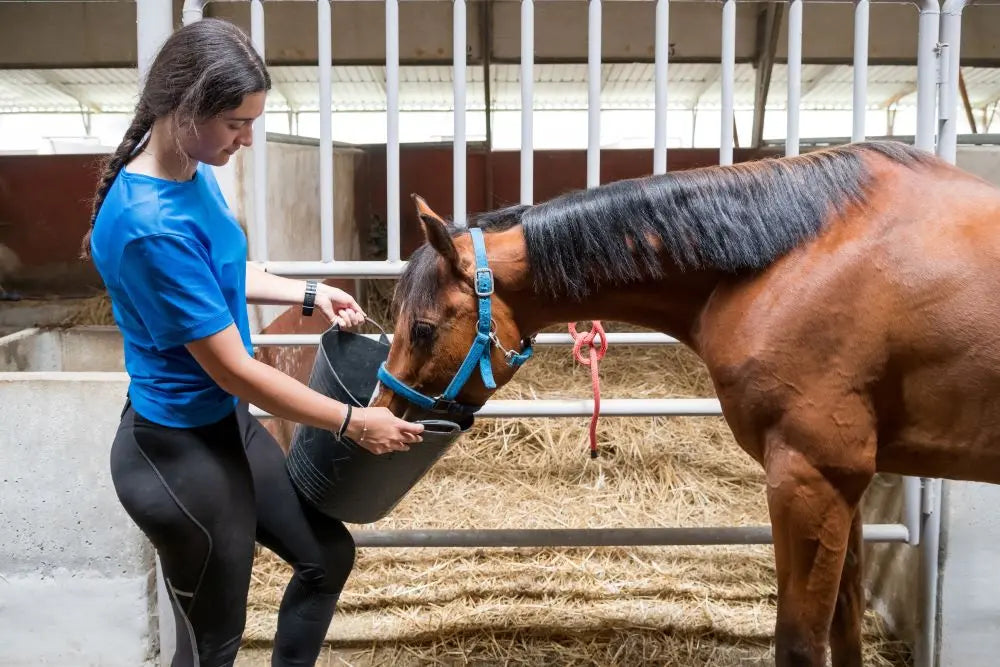From £6.99

Perfecting Autumn Horse Care: From Feed to Routine Adjustments
As the warm days of summer give way to the crisp air of autumn, it’s essential to start considering how these seasonal changes will impact your horse's care. "Adjusting horse feed for autumn" is critical, particularly in the UK, where the change in weather can affect nutritional needs, exercise routines, and overall health. This blog post delves into the various aspects of autumn horse care, ensuring your equine companion thrives throughout this transitional period.
Evaluating and Adjusting Autumn Horse Nutrition UK
As temperatures drop, your horse's nutritional requirements will shift. Focus on maintaining energy levels whilst avoiding overfeeding. Evaluate the quality of forage; autumn pastures often contain higher sugar levels due to fresh grass growth, which can be problematic for horses prone to laminitis or metabolic issues. Supplement grazing with hay to regulate caloric intake and ensure sufficient fibre for digestive health. Integrating a balanced mix of vitamins and minerals into your horse's diet is essential for overall wellness during colder months. Consult a vet or equine nutritionist to tailor a feeding plan that meets your horse's specific needs. Adjustments might include reducing high-calorie feeds and introducing more forage to maintain optimal body condition.
The Importance of Monitoring Horse Weight and Condition
Regularly monitoring your horse's weight and condition during autumn is essential for maintaining their health. The shift in forage availability and exercise can impact how well your horse maintains body weight. Use a weight tape or scale monthly to track any changes, and complement this with visual assessments to check for signs of weight gain or loss.
The Henneke Body Condition Scoring System can be a valuable tool in assessing your horse's condition, ensuring they stay within a healthy range. If you notice weight fluctuations, it may be necessary to adjust their feed or exercise regimen accordingly. For instance, increasing caloric intake for weight loss or reducing feed and enhancing exercise for weight gain can help maintain optimal condition. Regular checks and timely adjustments are key to navigating the seasonal changes effectively.
Transitioning Your Horse to Autumn Pastures Safely
As the leaves change colour, so too does the quality of your horse’s grazing. **Horse pasture management in autumn** requires careful attention to ensure your horse is not exposed to excess sugars and other risks.
When transitioning your horse to autumn pastures, take time to observe the grass's condition. Allowing your horse to graze slowly can help them adapt to the richer grasses that may be present in the early part of the season. Limit turnout time initially, increasing it gradually to prevent digestive upset.
Monitor your horse for signs of colic or laminitis, especially if they are prone to these issues. Providing access to a dry, less sugary area can help manage their intake effectively.
Adjusting Exercise and Work Routines for Cooler Weather
As autumn sets in, it's vital to modify your horse's exercise routines to suit the cooler weather and varying daylight hours. To prevent injury, ensure your horse has extra time to warm up before engaging in strenuous activities, as muscles can be stiffer in the chillier conditions.
Incorporate a variety of exercises to keep your horse engaged and accommodate their changing stamina levels. Slow, extended rides can be very beneficial in cooler weather, and adding groundwork can help maintain fitness while allowing you to adjust your routine gradually.
Keep a close eye on your horse's energy levels and behaviour. These can provide valuable insights into how well they are adapting to changes in their exercise regime. If you notice any signs of fatigue or reluctance, it may be necessary to tweak their workout plan accordingly.
Remember that wetter conditions can make surfaces slippery and increase the risk of falls. Therefore, ensure that the areas where you exercise your horse are safe and well-maintained to avoid accidents. Adapting your horse’s exercise routine not only maintains their physical fitness but also supports their mental wellbeing during the seasonal transition.
Preparing Your Horse for Colder Nights and Wet Weather
As autumn progresses, preparing your horse for colder nights and wet weather becomes increasingly important. Ensuring they have adequate shelter is paramount. A well-ventilated stable that offers protection from draughts and dampness will help keep your horse comfortable and healthy.
Deep bedding materials such as straw or shavings can provide extra insulation against the cold ground, making nights more comfortable. Additionally, consider using rubber mats for added warmth and cushioning.
For horses that spend time outdoors, investing in a high-quality waterproof rug is essential. These rugs not only keep your horse dry but also shield them from chilly winds. For particularly cold nights, layering rugs can provide additional warmth, though it's important to avoid over-rugging, which can cause overheating.
Maintaining clean and dry conditions in the stable and paddock is also crucial. Wet, muddy environments can lead to issues such as mud fever, so regular checks and maintenance of your horse's living area are necessary.
In wet weather, ensuring your horse's hooves remain dry and well-maintained is vital to prevent problems like thrush. Regularly picking and inspecting hooves, combined with the use of hoof conditioners, can help keep them healthy and resilient against the damp.
Finally, always have a plan in place for sudden weather changes. Having an array of rugs, extra bedding, and reliable shelter options will help you swiftly adapt to unpredictable autumn weather, ensuring your horse remains comfortable and healthy throughout the season.
Finding Quality Equestrian Supplies for Autumn Needs
With the onset of autumn, sourcing the right equestrian supplies can make a significant difference in your horse's comfort and health. Whilst local shops might have limited stock, online retailers offer a broader selection of specialised products tailored for seasonal needs. Prioritise essentials such as high-quality feed, waterproof rugs, and supplements designed for autumn nutrition. Pay attention to customer reviews and expert recommendations to ensure you're choosing reputable brands.
Additionally, look for suppliers who provide detailed product information and are responsive to customer enquiries. Building a rapport with a trusted supplier can streamline your shopping experience, ensuring you have access to the necessary items as the weather changes. Consider signing up for newsletters or loyalty programmes to stay informed about seasonal promotions and new arrivals.
For those hard-to-find items, specialised equestrian shops or direct purchases from manufacturers can be invaluable. Also, exploring second-hand options through local equestrian communities or online marketplaces can sometimes yield quality finds at more affordable prices. By leveraging these resources, you can better equip your horse for the autumn months, ensuring they remain healthy and comfortable.
Health Checks and Veterinary Care During Autumn Transition
As autumn progresses, your horse's health needs will naturally shift, making regular veterinary care crucial. Autumn brings unique challenges such as respiratory issues from increased stable time and potential colic from dietary changes. Schedule a veterinary visit to address these concerns and to update any necessary vaccinations and deworming protocols.
Monitor your horse closely for signs of discomfort or illness, such as coughing, nasal discharge, or changes in eating habits. Swiftly addressing these symptoms can prevent more serious health issues. Consult your vet about the best ways to boost your horse's immune system during this time, possibly through dietary supplements or adjustments.
Hoof health also requires extra attention in autumn. The wet and muddy conditions can exacerbate issues like thrush, so ensure regular hoof cleaning and consider applying appropriate treatments as recommended by your vet.
Discuss with your vet any changes in your horse's exercise routine, as mentioned earlier, to ensure they align with your horse’s health needs. A well-rounded autumn care plan that includes regular veterinary check-ups will help you address any health issues early, keeping your horse comfortable and healthy throughout the season.
Building a Consistent Autumn Care Routine for Your Horse
A consistent care routine is pivotal in maintaining your horse's health and wellbeing throughout the autumn months. Begin by establishing a regular feeding schedule that accommodates your horse's nutritional needs as discussed earlier. Consistency in meal times can help prevent digestive issues and ensure your horse is receiving a balanced diet.
Incorporate daily exercise into your routine, mindful of the adjustments needed for cooler weather and shorter daylight hours. Whether it's a gentle ride, groundwork, or turnout time, regular physical activity is essential for keeping your horse fit and mentally stimulated. Always account for weather conditions, ensuring that exercise areas remain safe and free from hazards like slippery surfaces.
Daily health checks should also form a core part of your routine. These checks allow you to monitor for any early signs of illness or discomfort. Pay attention to your horse's behaviour, appetite, and physical condition, noting any changes that might warrant a vet’s attention.
Managing your horse's living environment is equally important. Regularly clean and maintain stables, ensuring they are dry and well-ventilated to prevent respiratory issues and other health problems. For horses that spend time outdoors, ensure they have adequate shelter and are appropriately rugged to stay warm and dry.
Lastly, keep a detailed journal of your horse's care routine, including feeding, exercise, health checks, and any observations. This record can be invaluable for identifying patterns and making informed adjustments as needed. By adhering to a consistent care routine, you can help your horse smoothly transition into autumn, ensuring they remain healthy and happy.
